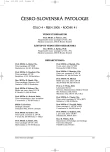Autoimmune Gastritis. A Clinicopathologic Study of 25 Cases
Authors:
A. Chlumská 1,2; L. Boudová 1; Z. Beneš 3; M. Zámečník 1,2
Authors‘ workplace:
Šikl’s Department of Pathology, Faculty Hospital
Charles University, Pilsen, Czech Republic
1; Laboratory of Surgical Pathology, Pilsen, Czech Republic
2; Department of Hepatogastroenterology, Thomayer Faculty Hospital
Charles University, Prague, Czech Republic
3
Published in:
Čes.-slov. Patol., 41, 2005, No. 4, p. 137-142
Category:
Original Article
Overview
The histopathological diagnosis of autoimmune gastritis (AG) in its early stages can be a diagnostic challenge. Even some advanced cases with complete atrophy of the corpus mucosa may be difficult to recognize. To establish the diagnosis of autoimmune gastritis, several histological features should be assessed and combined with immunostains for enterochromaffin cell-like (ECL) cells and G-cells. The main histological criteria include a mononuclear infiltrate within the lamina propria, foci of destruction of oxyntic glands, intestinal metaplasia (IM), pyloric metaplasia, and parietal cell pseudohypertrophy. These criteria were evaluated in our series of 25 patients with achlorhydria and/or megaloblastic anemia. Some of our patients presented with nonspecific gastrointestinal symptoms. The age ranged between 46 and 79 years; one male patient was only 31 years old. Histologically, the corpus mucosa displayed in all cases chronic inflammation with focal complete IM and advanced pyloric metaplasia. In 4 patients, oxyntic glands were destructed in some sites. There was a pancreatic metaplasia of acinar type in 2 patients and a minimal focal pseudohypertrophy of parietal cells in the 31-year-old man. A tubular adenoma with a low-grade dysplasia was found in one female patient. Immunohistochemically, chromogranin-A highlighted linear or nodular hyperplasia of ECL cells in 19 patients, and adenomatoid ECL hyperplasia in one case (80%). In the remaining cases hyperplasia of ECL cells could not be recognized from their normal count. In 13 cases (52%) a few ECL cells were seen also in IM. Regarding associated pathology, in one woman with nodular ECL cell hyperplasia, a gastric carcinoid was removed endoscopically. The reaction with gastrin antibody revealed in 11 cases (44%) a small number of G cells in IM in the corpus mucosa. In 18 patients, antral mucosa was examined as well. In 8 patients, the mucosa was normal; in 10 cases, a mild chronic inactive gastritis was diagnosed, and in 15 patients G-cell hyperplasia was found. In accordance with other studies, we show that the diagnosis of AG may be established microscopically in endoscopic specimens of the gastric body mucosa when histologic features and immunohistochemical detection of ECL and G cell hyperplasia are combined.
Key words:
autoimmune gastritis – histology – immunohistochemistry - ECL cell hyperplasia – G cells
Labels
Anatomical pathology Forensic medical examiner ToxicologyArticle was published in
Czecho-Slovak Pathology

2005 Issue 4
Most read in this issue
- Autoimmune Gastritis. A Clinicopathologic Study of 25 Cases
- Melanoma Simulating Malignant Soft Tissue Tumour
- Pulmonary Veins and Atrial Fibrillation: A Pathological Study of 100 Hearts
- Gastrointestinal Stromal Tumor (GIST) with Glandular Component. A Report of an Unusual Tumor Resembling Adenosarcoma
